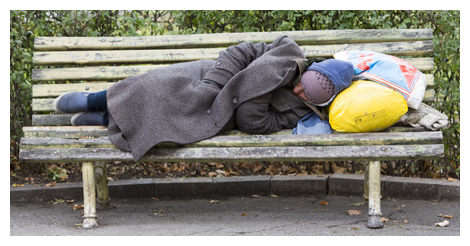
Bum Fights: Dehumanizing the Homeless for Profit
When it comes to entertainment, there is no shortage of genres from which to choose. Romance, Comedy, Action, Thrillers, and … Bum Fights?
The Bum Fights1 film series features teenagers and homeless men (most notably Rufus Hannah and Donnie Brennan) fighting and attempting deplorable “stunts” in exchange for money, alcohol, or other incentives. The videos, the first of which was released in 2002, have been widely criticized by the National Coalition for the Homeless and others, including Phil McGraw of the popular show Dr. Phil, and the late Ed Bradley of 60 Minutes.
In the videos, the homeless fight each other, drink urine, get their hair set on fire, or are terrorized by a man who calls himself the “Bum Hunter.” The man uses duct tape to tie up the homeless, then kicks and hits them, leaving them unable to move. Sometimes he puts them into the back of a white van and drops them off at another location, kicking or hitting them as he thrusts them out of the van.
In response to this series, Kyle S. Bunds of North Carolina State University, and Joshua I. Newman and Michael D. Giardina of Florida State University, offered a critical analysis to uncover what can be learned from these videos and their popularity.
The Objectification of Homeless People
In a study released in 2014, the National Coalition for the Homeless (NCH) found that violence against homeless individuals—often referred to as “bum bashing”—had caused the deaths of at least 379 people between 1999 and 2012. This figure represents only the incidents that were reported, says the NCH, but because homeless people tend not to have families or friends to report them missing, it is difficult to know the actual number of deaths each year.
These killings and the success of Bum Fights reveal attitudes and behaviors that actively objectify, dehumanize, and create a perception of the homeless as the “other.” Bunds et al. argue that the media, public policy, and the way in which communities, corporations, and governments conceive and plan public space have laid the foundation that makes it acceptable to exploit the homeless for financial gain and fame. A culture of neoliberalism, individualism, and dismissal of social welfare programs that are intended to help the poor also contribute to the success of the Bum Fights series.
The authors write, “In these videos, the homeless body is at once nothing—to be disposed of and viewed as a worthless leech on society— and not nothing—a very commercial entity to be capitalized upon.” In other words, because the homeless are not contributing to society (specifically the free market society), they become fair game for those who are contributing to society to use them for money-making purposes. From this perspective, there are winners and losers—the winners are those who “contribute,” and the losers are homeless individuals.
The Perception of Disposability
Social media, television, and other media allow individuals to be entertained by the violent culture of homelessness from a distance. This distance, in turn, makes viewers active consumers of poverty. The authors write: “Much like first-person shooter video games that allow us to ‘experience’ the horrors of war in the safety of our living rooms, we can virtually consume poverty without ever having to engage in the material realities of poverty itself.” The Bum Fights videos separate the human condition of homelessness from the experience of those who do not engage with poverty directly and perpetuate the perception of homeless people as worthless.
The videos portray homeless people as “undeserving, pathological, and irresponsible.” Viewers who buy into this portrayal then see the homeless as undeserving of help and the public space they occupy. So, who owns the public spaces where homeless people live? The authors argue that public spaces in cities are built to benefit the market and not necessarily the citizens of that community, making it possible for those who don’t contribute to the market to become disposable to society.
Politics and Disposability of “Bums”
Many cities and states are creating laws that would make it illegal for homeless people to occupy public spaces, and some politicians are promoting bills that would ban donations to homeless shelters. Other cities have used arrest sweeps in which they issue tickets for begging, and some have instituted physical removal from the city or detention for “quality of life” violations. Certain cities engage in street “scrub downs” by using high-pressured hoses to clean the streets (particularly of sleeping homeless people). In other instances, cities have engaged in burning or removing homeless people’s possessions that are left unattended on the street. All of this coincides with diminishing funds for low-income housing.
Conclusions
The authors paint a dark picture of society’s views of homeless people. They argue that the popularity of Bum Fightshighlights societal attitudes regarding the dehumanization and disposability of homeless people in U.S. communities. “As a country, we have developed a strong dislike for helping those we view as undeserving.” Moreover, the authors say that media distortions of the homeless condition, new legislation, and physical violence all contribute to the ingrained perception that some people are valuable while others are not. Those who profit from the vulnerable are just one indication of this perception.
1Due to the exploitative nature of Bum Fights, the authors have elected not to include a link to a YouTube video. However, the videos can be found by searching Bum Fights on YouTube.

